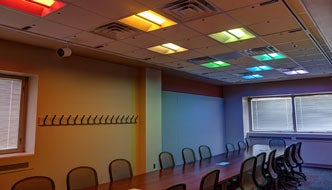 In an effort to study the effects of lighting on human health and diseases, the Smart Lighting Engineering Research Center (ERC) at Rensselaer recently installed a novel hospital inpatient lighting test bed for the study of automated lighting at the University of New Mexico Health Sciences Center (UNM-HSC) in Albuquerque, New Mexico. The test bed is a demonstration of the success of the multi-institutional, interdisciplinary Engineering Research Center Program funded by the National Science Foundation.
In an effort to study the effects of lighting on human health and diseases, the Smart Lighting Engineering Research Center (ERC) at Rensselaer recently installed a novel hospital inpatient lighting test bed for the study of automated lighting at the University of New Mexico Health Sciences Center (UNM-HSC) in Albuquerque, New Mexico. The test bed is a demonstration of the success of the multi-institutional, interdisciplinary Engineering Research Center Program funded by the National Science Foundation.
The smart-lighting equipped hospital room will enable, for the first time ever, side-by-side controlled studies about how LED lighting impacts human health. Researchers at UNM will utilize this facility to conduct studies regarding the treatment of circadian rhythm disorders and health conditions such as depression, Parkinson’s disease, and other neurological diseases that have previously been shown to respond to light exposure of the correct spectrum, intensity, and timing.
“At the ERC, we are building smart lighting systems that automatically adjust the right lighting for us at any given time, with light coming from the right direction, with the right color and intensity, optimized for human health and productivity,” said ERC Director Robert Karlicek.
 According to the ERC, what makes this lighting test bed so unique is the combination and integration of sensors and lighting controls. Not only can the lights be programmed to provide different spectral content and intensity, the sensors also constantly monitor the light in the room and provide feedback for maintaining and controlling the light. In addition, once the lighting is set to the preferred specifications, the lights will automatically adjust to maintain a balance of the desired lighting spectrum and intensity over the course of the day. For example, if it is cloudy, or if the blinds are raised or lowered, the lighting in the room remains constant.
According to the ERC, what makes this lighting test bed so unique is the combination and integration of sensors and lighting controls. Not only can the lights be programmed to provide different spectral content and intensity, the sensors also constantly monitor the light in the room and provide feedback for maintaining and controlling the light. In addition, once the lighting is set to the preferred specifications, the lights will automatically adjust to maintain a balance of the desired lighting spectrum and intensity over the course of the day. For example, if it is cloudy, or if the blinds are raised or lowered, the lighting in the room remains constant.
The computer-controlled lighting system was designed using optimized products from ERC industry members Telelumen, Heptagon, and Austria Microsystems. The system can mimic the diurnal and seasonal variations of natural outdoor light, or can provide light with qualities specially customized to treat sleep-wake disorders and medical problems such as depression.
“Not only will this new technology allow us to study classic circadian rhythm sleep-wake disorders, but now we will be able to also investigate the effect light plays on such behavioral health disorders as depression and dementia,” said Lee Brown, M.D., professor of internal medicine and director of the UNM-HSC Sleep Disorders Program.
“The sensors in the test bed can also be used to determine occupancy in the room,” said Steven R.J. Brueck, UNM Distinguished Professor Emeritus of Electrical and Computer Engineering, UNM Lead for the Smart Lighting Engineering Research Center, and emeritus director of the Center for High Technology Materials. “The system also can collect feedback on variables ranging from the number and position of room occupants to the test subject’s sleep/wake patterns, and even alert a nurses’ station if a patient falls—all without the need for cameras with their associated privacy issues.”
“The first research study involving the specially equipped room will investigate whether individuals with delayed sleep-wake phase disorder (‘night owls’), a condition common to college students, can be treated by varying the spectrum of light they are exposed to throughout the day,” Brown added. “Other potential research areas range from hospital-induced conditions such as post-operative delirium and ICU psychosis, to the effects of light on the sleep patterns of patients receiving chemotherapy or those suffering from depression.”
“In the future, everyone may have access to this technology,” said Brown. “Knowing more about the effects of lighting may actually help physicians to prevent disease and increase productivity in healthy persons.”
“This new ability to dynamically control the color properties of lighting is being studied in health care, education, and workplace settings to improve well-being and productivity, but there is still a lot to learn,” Karlicek added.


